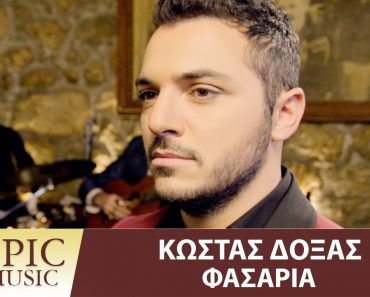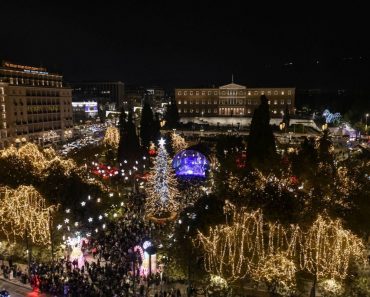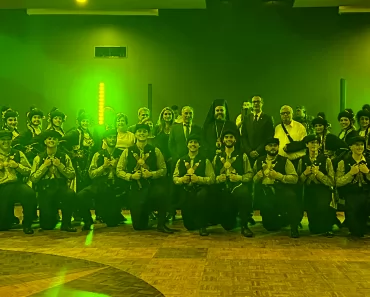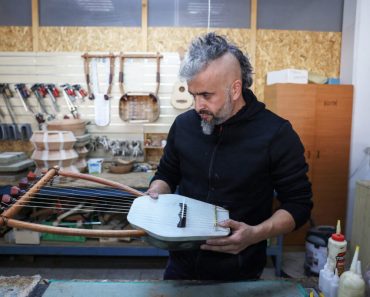
The poster for the Greek Youth Symphony Orchestra concert at the entrance of Carnegie Hall featuring its founder and artistic director, Dionysis Grammenos.
Beyond the electrifying election atmosphere and the usual buzz of the city that never sleeps, there was something else very exciting going on in New York City on the first weekend of November – albeit of a more niche nature.
The passengers on Emirates flight EK 209 got an inkling of it as they watched a large group of young men and women come on board carrying cases in the shape of cellos or tubas. Passport control officers at New Jersey also had an inkling when they asked about the contents of the youngsters’ luggage and got “a violin” or “a trumpet” as an answer.
The New Yorkers who saw the 95 awestruck young men and women taking photographs at the Empire State Building, Central Park and Ground Zero, or riding the subway back to their hotel, their fingers busy mimicking their notes as they wondered if they’d have enough time to squeeze in some more practice, were clueless.
That is, except for those who knew that the Greek Youth Symphony Orchestra (GYSO) was performing at one of the world’s most iconic venues, Carnegie Hall, on the evening of November 3, under the baton of its founder and artistic director, Dionysis Grammenos.
The members of the audience started packing the Stern Auditorium well ahead of the start of the performance, greeting friends and acquaintances.
Taking the floor before the show, Nicholas Alexos, a committee member of The Hellenic Initiative (one of the backers of the show, along with the support of American and Greek donors), noted the presence in the audience of Archbishop of America Elpidophoros and the Greek consul in New York, Iphigenia Kanara, before going on to announce the program: “Rewind” by British composer Anna Clyne (who was also in the audience), a selection of Nikos Skalkottas’ Greek Dances (which had premiered at Carnegie Hall 70 years earlier with the New York Philharmonic conducted by Dimitri Mitropoulos) and Leonard Bernstein’s Symphonic Dances from “West Side Story.”
“The real masterpiece, however, is the Greek Youth Symphony Orchestra,” Alexos added.
He wasn’t wrong either. In “Rewind,” the orchestra showed a perfect grasp of all the nuances of what is a multifaceted piece despite its short duration. They then launched into the demanding Greek Dances with youthful passion and professional poise, glancing at the conductor when needed while feeling the music run through their bodies. By the time they reached the Symphonic Dances, they were clearly enjoying themselves immensely, but without detracting from the sensitivity of the more lyrical parts.

Their delightful performance was, of course, also due to the passion and attention to detail coming from the podium – not to mention Grammenos’ obvious confidence in his ensemble. As the auditorium burst into applause, the maestro gestured each musician to stand up and take a bow, before three more encores: Bernstein’s “Candide,” Arturo Marquez’s Danzon No 2 and, to top it all off, Mikis Theodorakis’ “Beautiful City,” in choral form, which was so wonderfully performed there were more than a few teary eyes in the house.
“I was genuinely surprised! I felt their passion. It’s not usual to have three encores,” commented Richard Zang from San Francisco, who attends Carnegie Hall wherever he can, regardless of who is performing.
“I was invited by some relatives who have Greek roots. I didn’t know what the performance was, but I am delighted! The orchestra is wonderful and the musicians are so talented,” said Elizabeth Bueller.
For Violetta Kapsali-Bueller from Illinois, Skalkottas’ pieces reminded her of the traditional dances she learned at the Saint George Greek School in Chicago. “We learned so many wonderful things at that school,” she said. “And these young people showed us how much we have accomplished as Greeks, how we are able to create beautiful things out of adversity.”
The musicians were no less delighted by the experience. “Carnegie Hall was like an impossible dream come true,” violinist Stavros Samaras told Kathimerini on the flight back to Greece. “I couldn’t wrap my head around the fact that we were suddenly there, performing, with an audience in front of us,” agreed bassoonist Andreas Anthopoulos. Violinist Charis Chavelos was awed by the “unforgettable” experience of performing in the same place where greats like Tchaikovsky and Mahler once played, while Stefania Hasapi, also a violinist, was impressed by the acoustics. “It was like playing chamber music; I could hear each individual instrument,” she said.
And what did the conductor have to say? “There’s the legend of Carnegie Hall, to begin with. The first thing you see when you enter the conductor’s suite is photographs of all the greats who came before you, from [Leopold] Stokowski to [George] Szell. Conducting Bernstein’s music from the same exact podium where he conducted it is also a very special thing. And feeling that you are creating something in a venue that has defined musical history in America and beyond for the past 130 years is a great moment,” Grammenos told Kathimerini.
What does the future hold for the GYSO? “What I can say with certainty is that you’ll be surprised,” said Grammenos. “These are the best young Greek musicians and, yes, I have confidence in their talent and skill. All of them are here for one reason only: to push their artistic limits, to explore new works and to keep setting the bar higher with every performance.”







